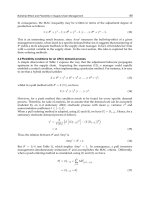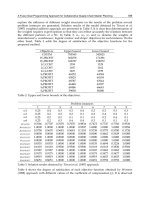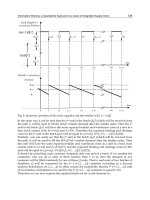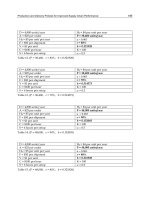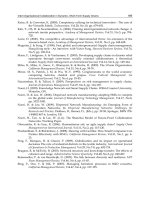Supply Chain Management Pathways for Research and Practice Part 1 pot
Bạn đang xem bản rút gọn của tài liệu. Xem và tải ngay bản đầy đủ của tài liệu tại đây (588.44 KB, 20 trang )
SUPPLY CHAIN
MANAGEMENT –
PATHWAYS FOR
RESEARCH AND PRACTICE
Edited by Dilek Önkal and Emel Aktas
Supply Chain Management
–
Pathways for Research and Practice
Edited by Dilek Önkal and Emel Aktas
Published by InTech
Janeza Trdine 9, 51000 Rijeka, Croatia
Copyright © 2011 InTech
All chapters are Open Access articles distributed under the Creative Commons
Non Commercial Share Alike Attribution 3.0 license, which permits to copy,
distribute, transmit, and adapt the work in any medium, so long as the original
work is properly cited. After this work has been published by InTech, authors
have the right to republish it, in whole or part, in any publication of which they
are the author, and to make other personal use of the work. Any republication,
referencing or personal use of the work must explicitly identify the original source.
Statements and opinions expressed in the chapters are these of the individual contributors
and not necessarily those of the editors or publisher. No responsibility is accepted
for the accuracy of information contained in the published articles. The publisher
assumes no responsibility for any damage or injury to persons or property arising out
of the use of any materials, instructions, methods or ideas contained in the book.
Publishing Process Manager Iva Lipovic
Technical Editor Teodora Smiljanic
Cover Designer Jan Hyrat
Image Copyright Cre8tive Images, 2006. Used under license from Shutterstock.com
First published July, 2011
Printed in Croatia
A free online edition of this book is available at www.intechopen.com
Additional hard copies can be obtained from
Supply Chain Management
–
Pathways for Research and Practice,
Edited by Dilek Önkal and Emel Aktas
p. cm.
ISBN 978-953-307-294-4
free online editions of InTech
Books and Journals can be found at
www.intechopen.com
Contents
Preface IX
Chapter 1 Lean Supply Chain Practices and
Performance in the Context of Malaysia 1
Azman Daud and Suhaiza Zailani
Chapter 2 Service Supply Chain: How Does It Effects
to the Logistics Service Effectiveness? 15
Kavighta Mohan and Suhaiza Zailani
Chapter 3 Supply Chain Quality Management 25
Lynn A. Fish
Chapter 4 Collaborative Quality Management 43
Goknur Arzu Akyuz
Chapter 5 Supply Chain Quality Management
by Contract Design 57
Qin Su and Qiang Liu
Chapter 6 Supply Chain Flexibility:
Managerial Implications 75
Dilek Önkal and Emel Aktas
Chapter 7 Bullwhip-Effect and Flexibility
in Supply Chain Management 85
Javier Pereira, Luciano Ahumada and Fernando Paredes
Chapter 8 A Fuzzy Goal Programming Approach
for Collaborative Supply Chain Master Planning 95
Manuel Díaz-Madroñero and David Peidro
Chapter 9 Information Sharing: a Quantitative Approach
to a Class of Integrated Supply Chain 115
Seyyed Mehdi Sahjadifar, Rasoul Haji,
Mostafa Hajiaghaei-Keshteli and Amir Mahdi Hendi
VI Contents
Chapter 10 Production and Delivery Policies
for Improved Supply Chain Performance 137
Seung-Lae Kim and Khalid Habib Mokhashi
Chapter 11 Inter-Organizational Collaboration in
Dynamic, Short-Term Supply Chains 157
Adrian Tan and Hamid Noori
Chapter 12 Advanced Supply Chain Planning
Systems (APS) Today and Tomorrow 171
Luis Antonio de Santa-Eulalia, Sophie D’Amours, Jean-Marc Frayret,
Cláudio César Menegusso and Rodrigo Cambiaghi Azevedo
Chapter 13 The Supply Chain Process
Management Maturity Model – SCPM3 201
Marcos Paulo Valadares de Oliveira, Marcelo Bronzo Ladeira
and Kevin P. McCormack
Chapter 14 Using Web Technologies
for Supply Chain Management 219
Mărincaş Delia Adriana and Voicilă Cristian
Preface
Challenges faced by supply chains appear to be growing exponentially under the
demands of increasingly complex business environments confronting the decision
makers. The world we live in now operates under interconnected economies that put
extra pressure on supply chains to fulfil ever-demanding customer preferences.
Relative attractiveness of manufacturing as well as consumption locations changes
very rapidly, which in consequence alters the economies of large scale production.
Coupled with the recent economic swings, supply chains in every country are obliged
to survive with substantially squeezed margins. Many supply chains do not have the
necessary tools and flexibility to deal with such fast changing conjunctures at either
the global or the local levels.
2010s are also witnessing further shortening of the product life cycles, forcing
producers to continually work on expanding product categories. Moreover, raw
material scarcity emerges as a gradually growing problem along with the increasing
labour costs. In this book, we tried to compile a selection of papers focusing on a wide
range of problems in the supply chain domain. Each chapter offers important insights
into understanding these problems as well as approaches to attaining effective
solutions.
The book starts with an investigation into lean supply chain practices and performance by
Azman Daud and Suhaiza Zailani. Service supply chain concepts are explored in the
2nd chapter by Kavighta Mohan and Suhaiza Zailani. This is followed by a series of
insightful chapters on the main theme of quality management, as examined by Lynn A.
Fish in Chapter 3, Goknur Arzu Akyuz in Chapter 4, and Qin Su and Qiang Liu in
Chapter 5. The next theme is supply chain flexibility, where managerial implications are
discussed by Dilek Onkal and Emel Aktas in Chapter 6; while Javier Pereira Luciano
Ahumada and Fernando Paredes discuss bullwhip effect and flexibility issues in
Chapter 7. Manuel Diaz-Madronero and David Peidro present a fuzzy goal
programming approach for collaborative supply chains in Chapter 8, followed by Mehdi
Sajadifar, Rasoul Haji, Mostafa Hajiaghaei-Keshteli, and Amir Mahdi Hendi’s focus on
information sharing in Chapter 9. Improved supply chain performance and the
associated production and delivery policy implications are investigated in Chapter 10 by
Seung-Lae Kim and Khalid Habib Mokhashi. Inter-organizational collaboration issues are
addressed by Adrian Tan and Hamid Noori in Chapter 11, while Chapter 12 presents
X Preface
work on advanced supply chain planning systems by Luis Antonio de Santa-Eulalia,
Sophie D’Amours, Jean-Marc Frayret and Claudio Cesar. A new supply chain process
management maturity model is introduced by Oliviera Marcos in Chapter 13. Finally, the
book concludes with a discussion of using internet technologies for supply chain
management by Marincas Delia Adriana.
Supply Chain Management is an important and prolific domain that will continue to
generate much research interest. We hope that the chapters collected in this book will
serve as a guide to future work on the issues that will influence supply chain
management practices, leading to efficient processes and effective decisions.
Dilek Önkal and Emel Aktas
Business School, Brunel University,
United Kingdom
1
Lean Supply Chain Practices and
Performance in the Context of Malaysia
Azman Daud and Suhaiza Zailani
Graduate School of Business,
Universiti Sains Malaysia, 11800, Penang,
Malaysia
1. Introduction
Supply chain nowadays becoming a vital entity to the organizations performance
measurement and metrics, has received much attention from researchers and practitioners.
To support this, Gunasekaran, Patel (2001) and McGaughy (2004) have discussed that the
role of these measures and metrics in the success of an organization cannot be overstated
because they affect strategic, tactical and operational planning and control. Some more, the
revolution of SCM in the last decade has testified that an increasing number of companies
seek to enhance performance beyond their own boundaries (Boyson et al., 1999; Proirier,
1999). Supply chain has been viewed on every perspective. According to Agarwal &
Shankar (2002), a supply chain is an inter-linked set of relationships connecting customer to
supplier, perhaps through a number of intermediate stages such as manufacturing,
warehousing and distribution processes.
Accordingly, Harland (1996) have clearly stated that supply chain also often refers either to
a process-oriented management approach to sourcing, producing, and delivering goods and
services to end customers or, in a broader meaning, to the co-ordination of the various
actors belonging to the same supply chain. Intense competition compels companies to create
close relationships with their upstream and downstream partner (Togar & Ramaswami,
2004). In the competitive environment, most leading edge companies realized that by
transferring costs either upstream or downstream, they are actually not increasing their
competitiveness, since all costs ultimately make their way to consumers (Cigolini, Cozzi &
Perona, 2004). Hence, Cigolini, Cozzi and Perona (2004), have mentioned that supply chain
management guides firms to co-operate with a common goal to increase the overall channel
sales and profitability, rather than competing for a bigger share of a fixed profit. One
strategy for coordinating within and between firms with a focus on achieving efficiency,
eliminating waste or overburden and creating value in products is the concept of lean
management (Womack & Jones, 1996). Consequently, Vonderembse, Uppal, Huang, and
Dismukes (2006), highlighted on the strategies and methodologies for designing supply
chains that meet specific customer expectations. According to them, three different types of
supply chains can be defined:
1. A lean supply chain, which employs continuous improvement efforts which focuses on
eliminating waste or non-value steps along the chain.
Supply Chain Management – Pathways for Research and Practice
2
2. An agile supply chain, which responds to rapidly changing, continually fragmenting
global markets by being dynamic, context-specific, growth-oriented, and customer
focused.
3. A hybrid supply chain, which combines the capabilities of lean and agile supply chains
to create a supply network that, meets the needs of complex products.
Lean thinking is focused on eliminating waste from all processes while enhancing material
and information flow along the supply chain (McCullen & Towill, 2001). The impact of lean
thinking as a strategy for the supply chain and not just manufacturing is important and has
received a lot of interest from both industry (including service) and academia. Hence, the
purpose of this paper is to explore the implementation of lean supply chain management
practices in manufacturing industry in Malaysia, and identifies the impact of these practices
on lean supply chain performance.
2. Literature review
2.1 Lean basics
There are lots of definitions available to define “Lean”. For example, The National Institute
of Science and Technology (NIST/MEP, 1998) defines Lean as “A systematic approach to
indentifying and eliminating waste (non-value added activities) through continuous
improvement by following the product at the pull of the customer in pursuit of
perfection”(Buzby, Gerstemfeld, Voss & Zeng, 2002). Simply, lean means to create more
value for customers with fewer resources, in other words, the fundamental ideas is to
maximize customer value while minimizing waste. Actually, the word “Lean” was first used
in the Future Car Investigation by MIT professors to interpret Japan’s new production
system that do away with mass production (Womack et al., 1991; Macduffie & Helper, 1997;
Conti et al., 2006) since it produces much waste. “Waste” is defined as anything that
interferes with the smooth flow of production (Macduffie & Helper, 1997). The eight wastes
highlighted in TPS are overproduction, waiting, conveyance, over processing, excess
inventory, movement, defects and unused employee creativity, and the biggest one being
overproduction (Monden, 1998; Liker, 2004).
Wu and Wee (2009) concluded that the term “lean” means a series of activities or solutions
to eliminate waste, reduce non-value added (NVA) operations, and improve the value
added (VA). This VA and NVA concept were derived mainly from TPS. A lean organization
understands customer value and focuses its key processes to continuously increase it. The
ultimate goal is to provide perfect value to the customer through a perfect value creation
process that has zero waste. To make Lean success, level of thinking need to be change in
order to focus of management from optimizing separate technologies, assets, and vertical
departments to optimizing the flow of products and services through entire value streams
that flow horizontally across technologies, assets, and departments to customers (Lean
Enterprise Institute, 2009). Eliminating waste along entire value streams, instead of at
isolated points, creates processes that need less human effort, less space, less capital, and
less time to make products and services at far less costs and with much fewer defects,
compared with traditional business systems. Companies are able to respond to changing
customer desires with high variety, high quality, low cost, and with very fast throughput
times.
According to Anand and Kodali (2008), only in recent times, researchers have emphasized
that the theory and principles of lean and its associated tools, techniques, practices and
Lean Supply Chain Practices and Performance in the Context of Malaysia
3
procedures can be extended outside the boundaries of an organization to its supply chains.
However, the concept of lean supply chain was proposed in 1994, when the proponents of
lean manufacturing, Womack and Jones (1994) envisioned the concept of ‘lean enterprise’.
The supply chain management concept has evolved with it through the five distinct stages
shown in Figure 1 below.
Source: McKee & Ross (2009)
Fig. 1. Evolution of SCM
2.2 The Concepts and importance lean supply chain
Several researchers, such as Lee et al. (1997) and Lummus et al. (2003), explained that the
information transferred from one stage to another in supply chain tends to be distorted and
can misguide upstream members in the production decisions, resulting in wastes, thereby
affecting the coordination between the different stages of a supply chain. Lean supply chain
continuous improvement processes to focus on the elimination of waste or non valued-
added functions. These waste and non value-added stops across the supply chain and
reduce set of times to allow for the economic production of small quantities. Gordon (2008)
came out with his points that strongly support on lean supply chain best practices and
performance. Accordingly, there is a research by Accenture, INSEAD and Stanford
University show correlation between companies with a successful supply chain strategy and
significant financial success. The correlation focuses on four lean supply chain perspectives:
How organizations keep goods and services flowing in a smooth, uninterrupted and cost-
effectives fashion from suppliers to customer firms end to end. Inventory perspectives; How
do we keep minimal, but sufficient inventory in the supply chain pipeline in order to
provide good service levels without interruptions. Lean procurement; how can procurement
scale and improve its processes to minimize transactions, reduce total cost and work with
the best possible suppliers who meet its requirements, Adopting lean within customer and
supplier firms; how can business work to eliminate waste while adding value to its
customers. Bozdogan (2002) emphasized that the successful of lean supply chain
management principles derive from 10 Basic Lean Principles:
Focus on the supplier network value stream
Supply Chain Management – Pathways for Research and Practice
4
Eliminate waste
Synchronize flow
Minimize both transaction and production costs
Establish collaborative relationships while balancing cooperation and competition
Ensure visibility and transparency
Develop quick response capability
Manage uncertainty and risk
Align core competencies and complementary capabilities
Foster innovation and knowledge-sharing
Bozdogan (2002) has illustrated the differentiation between conventional versus lean model
adapted into lean supply chain management based on 22 characteristics identified. Refer to
table 1.
ILLUSTRATIVE
CONVENTIONAL MODEL LEAN MODEL
CHARACTERISTICS
Number & structure Many; vertical Fewer; clustered
Procurement personnel Large Limited
Outsourcing Cost-based Strategic
Nature of interactions Adversarial; zero-sum Cooperative, positive-sum
Relationship focus Transaction-focused Mutually-beneficial
Selection length Lowest price Performance
Contract length Short-term Long-term
Pricing practices Competitive bids Target costing
Price changes Upward Downward
Quality Inspection-intensive Designed-in
Delivery Large quantities Smaller quantities (JIT)
Inventory buffers Large Minimized, eliminated
Communication Limited; task-related Extensive; multi-level
Information flow Directive; one-way Collaborative; two-way
Role in development Limited; build-to-print Substantial
Production flexibility Low High
Technology sharing Very limited; nonexistent Extensive
Dedicated investments Minimal-to-some Substantial
Mutual commitment Very limited; nonexistent High
Governance Market-driven Self-governing
Future expectations No Guarantee Considerable
Source: Bozdogan (2002)
Table 1. The Comparison between Conventional and Lean Model
2.3 The lean supply chain’s practices
From the earlier analysis by (APICS, 2004; Manrodt, et al., 2005) and Aberdeen Group (2006),
there are significant differences between these two researches. APICS, 2004; Manrodt et al
(2005) focused more on lean supply chain level of practices (“Poor Practice”, “Inadequate
Lean Supply Chain Practices and Performance in the Context of Malaysia
5
Practice”, “Common Practice”, “Good Practice” and “Best Practice”) while Aberdeen Group
(2006) is focused more on level of adoption (“laggards”, “industry norm” and “best in class”)
of lean supply chain implementations. In conjunction to the objectives of the study, the APICS,
2004; Manrodt et al (2005) research framework on level of lean supply chain practices seems to
the perfect match and suitable to be used in order investigate the extent of lean supply chain
practices towards performances in Malaysia. If we go back to the research objectives, four
objectives related to the lean supply chain practices which are first, to investigate the extent of
implementation for lean supply chain practices in Malaysia and second, to examine the effects
of lean supply chain practices on the performance of the lean and lean supply chain in
Malaysia. Additionally the study is to examine the mediating effect of lean performance. This
argument perfectly supported the importance of framework selected.
Generally, from the literature review, there are four significant main practices of lean supply
chain such as demand management, standardization, waste management and
organizational behavior. The study however, will focus only two lean supply chain key
principles that have been identified and being grouped. This is due to the reason that the
study is focus on the outbound supply chain rather than inbound. Improving outbound
supply chain efficiencies has become a top priority for companies seeking to increase their
bottom line (Norek, 2002). The two main areas of improvement mentioned are Demand
Management (Demand Management together with Cost Management) and Waste (Waste
Management). These two main areas of lean supply chain key principles will be use to
investigate the best practices and effects of lean supply chain implementations and practices
in Malaysia. For every particular areas of improvement, the continuous of details discussion
of the subsequences will be the main agenda of the best practices study. For example,
Demand Management will be focused on Demand Signal, Demand Collaboration, Sales and
Operation Planning and Inventory Management Practice. Waste will be discussed on waste
management and value added activities and environmental issue awareness. The study then
will continue to focus on the lean supply chain performance.
2.4 Lean performances
Lean performance is total internal lean optimization process. To develop a lean supply
chain, there is need to apply lean to the supply chain as a system (Phelps, 2004). Lean is an
approach that identifies the value inherent in specific products, identifies the value stream
for each product, supports the flow of value, lets the customer pull value from the producer,
and pursues perfection. It is through this holistic, enterprise-wide approach to lean
implementation that the theory extends beyond functional strategy to a broader supply
chain strategy employed by the company (Goldsby, 2005). The strengths of lean approach
are lean's more immediate and practical focus on waste, flow and flexibility (Industry Week,
2010). A lean organization optimizes the flow of products and services to its customers. It
delivers customer value by:
Reducing lead times
Improving quality
Eliminating waste
Reducing the total costs
Engaging and energizing people (Industry Week, 2010).
Continuous Business Improvement (2010) has introduced 20 keys to world class
competitiveness and total workplace improvement which are derived to the lean
performances on better quality, faster throughput and cheaper cost.
Supply Chain Management – Pathways for Research and Practice
6
2.5 Framework and hypotheses
As lean practices will be the core component of organizations business performances, these
variables may also significantly influence the lean performance, which need to be focus in
this study. Therefore, this theoretical framework (Figure 2) is served to investigate the
performances rate of independent variables (lean practices).
Fig. 2. Proposed Theoretical Framework
2.6 Hypothesis
2.6.1 Lean supply chain practices and lean performance
In term of demand management, it is very important that how well firms manage the
demand signal, demand collaboration, sales and operation planning and inventory
management is also reflected in how a lean supply chain system view as a system (Phelps,
2004; APICS, 2004; Manrodt et al, 2005). Lean performance is total internal lean optimization
process; therefore demand management is vital to play their role to accept the concept of
lean performance within their processes subsets. The strengths of lean approach are
leanness are more immediate and practical focus on waste, flow and flexibility (Industry
Week, 2010), therefore, supply chain partners including the upstream suppliers and
downstream customers can work together as a team to provide value to the end-user
customer (APICS, 2004; Manrodt et al., 2005). Some internal issuses like “offset” of Bill of
Materials (BOMs)’s explosions; can be handle effectively by better understand the “real”
demand they are projecting (APICS, 2004; Manrodt et al., 2005) in making used the
approaches of lean performances like Reducing lead times, improving quality, eliminating
waste, reducing the total costs, engaging and energizing people (Industry Week, 2010).
In the perspectives of waste management, lean performances are important to generate
flexibility in order to control organization waste; the focus is to reduce waste; not costs,
(APICS, 2004; Manrodt et al 2005). Anything that delays or impedes supply chain's flow
must be analyzed as a potential non-value added activity (Craig, 2004). Some of the lean
performances initiatives can be taken such as Engaging and energizing people (Industry
Week, 2010) and supply chain partners have to work together and individually to eliminate
wasteful processes and excess inventory across the chain. This elimination of waste should
have a significant by-product: a reduction in cost for the supply chain. Therefore, the
following hypothesis is proposed;
H1: Organizations that practice the lean supply chain practices are significantly impact
lean performance.
3. Methodology
3.1 Research design
In this study, the units being analyzed which are comprise of electrical, electronics and
electronics manufacturing services companies in Malaysia. These manufacturing industries
recorded the fastest growth rate in terms of its growth of industry by sub-sectors. Sampling
H1
Satisfaction
Lean Performance
Demand Management
Waste Management
Lean Supply Chain Practices and Performance in the Context of Malaysia
7
is an option and one of the efficient process that been using by a quantitative research of
selecting a sufficient number of data and information from the selected population. By
selecting the right sample, it is possible to capture the characteristics of the data or
information to the population elements (Sekaran, 2003). The sampling technique used for
this research is based on proportionate stratified random sampling. According to FMM,
2010, there are over 1,000 manufacturers and supporting industries in the Electrical &
Electronics Industry. 551 companies’ related companies have been identified including
MNC and SME sectors which are suitable for the test case in order to study and investigate
the lean supply chain practices and performances metrics.
The data collection of this study will be carried out by using email, hand distribution and
mailing to the respondent. As suggested by Sekaran (2003), the analysis samples should be
at least ten times the number of variables in a study. Thus, 40 respondents are targeted in
this study, as there are a total of four variables. Roscoe’s (1975) rule of thumb suggest
samples sizes that are greater than 30 and less than 500 should be appropriate for most
research. The minimum sample should be at least 10 times than the number of variables.
From the respondents received, 114 out of 551 targeted questionnaires responded.
3.2 Development of questionnaire
In this study, measures of variables were developed based on the literature review in
addition to the survey. To date, very few large scale studies were conducted regarding lean
supply chain practices, lean performances, and lean supply chain performances(Aberdeen
Group (2006); APICS, 2004; Manrodt, Abott &Vitasek, 2005 ). Therefore, few reliable and
validated measures were found in the literature. Accordingly, the study depends on the
available that are derived from the issues and questions raised in the literature. The
questions were taken directly from the past questionnaires with few modifications made to
the model requirements (APICS, 2004; Manrodt, Abott &Vitasek, 2005).
In this study, lean supply chain practices have two dimensions of the independent variables
which are: demand management and waste management, mostly following the similar
study on lean supply chain practices (e.g., Aberdeen Group (2006); APICS, 2004; Manrodt,
Abott &Vitasek, 2005). The study uses a 5-point Likert as point of scales for all dimensions
of lean supply chain practices. The scale ranges from 1= low extent to 5= very high extent. In
this study demand management is defined as how effectively the lean organizations handle
their operations by moving to a pull system (Ducharme and Lucansky (2002), that is,
products or services are pulled when requested by the final customer. There are four
important facets need to be tested under demand management which are including of
demand signal, demand collaboration, sales and operations planning, and inventory
management practices (APICS, 2004; Manrodt, Abott &Vitasek, 2005).
In this study waste management is defined as to eliminate activities that do not add value
(waste) in the manufacturing processes and increase the value-added activities which are
those contribute to the highest level of efficiency in placing the final product at the customer
In addition, it is about identifying and eliminating waste; as measured in time, inventory
and cost across the complete lean supply chain. This requires continuous effort and
improvement (Craig, 2004; Ilyas, Shankar & Banwet, 2008). There are two important facets
need to be tested under waste management which are including of demand signal, demand
collaboration, sales and operations planning, and inventory management practices (APICS,
2004; Manrodt, Abott &Vitasek, 2005).
Supply Chain Management – Pathways for Research and Practice
8
Lean performances communicate through strengths of lean approaches, which are lean's
more immediate and practical focus on waste, flow and flexibility (Industry Week, 2010). In
this study, base on (Continuous Business Improvement, 2010) 20 keys to world class
competitiveness and total workplace improvement frameworks suggested that the total
performances comes from three important facets; which are better quality, faster throughput
and cheaper cost.
4. Analysis
4.1 Profile of organizations
The profile data has been surveyed into four major sectors which are variables, categories,
frequency of profiling attempts and percentage. For the number of full time employees data,
the range of > 150 employees shows the highest (82%) and follow by 5-50 employees (9.6%)
and the lowest is < 5 employees which is 10(8.8%). Most of the companies best categorized
fully owned by foreign company (63%), is a large type of size (68%). Data shows that
Penang state contributed the highest data (33%) and Pahang (1.8%) contributed as the
lowest for state profile. Here, we can conclude that Penang is the most state with the
Electrical &Electronics and Electronics Manufacturing Services companies on most of
manufacturing kind of operations in Malaysia. The highest age of firm is 11 years – 15 years
(33%) operating in Malaysia and the newest which are < 5 years is the lowest, contribute to
9.6% on profile rate.
The profile data mostly covers all general data of the gender, age, race and marital status.
The interesting is to know the level of educations and positions profile among respondents
to see whether the survey is suitable to be focused to the target segments. For the highest
academic qualification, bachelor degree contributed the highest score which is 47.4%,
follows by master degree which is 42.1%. The lowest is diploma holder with 10.5%. For
positions in the current organizations, the highest score is Middle Management (Manager,
Senior Engineer /Executive) with the score of 71.9% and follows by Lower Management
(Executive, Engineer, and Supervisor), 21.9% and the lowest is Top Management equivalent
to 6.1%.
4.2 Regression for demand management
To test the hypotheses generated from the tested variables, a multiple regression analysis
was used. The results are presented in Table 2. The R² was 0.15 indicating that 15 percent of
the variation of better quality can be explained by the demand management and the F-value
of 4.568 was significant at the 0.01 level. Demand collaboration (β = 0.237; p<0.05) and sales
and operations planning (β = 0.262; p<0.01) were positive and significantly related to better
quality. However, the demand signal (β = 033; p>0.05) and inventory management practice
(β = 030; p>0.05) were found no relationship with better quality.The R² was 0.27 indicating
that 27 percent of the variation of faster throughput can be explained by the demand
management and the F-value of 9.990 was significant at the 0.001 level. Sales and operations
planning (β = 0.394; p<0.001) and inventory management practice (β = 0.325; p<0.001) were
positive and significantly related to faster throughput. Demand signal (β = 0.057; p>0.05)
and demand collaboration (β = 038; p>0.05) were found no relationship with faster
throughput. The R² was 0.44 indicating that 44 percent of the variation of faster throughput
can be explained by the demand management and the F-value of 21.055 was significant at
the 0.001 level. Demand collaboration (β = 0.462; p<0.001) and sales and operations planning





